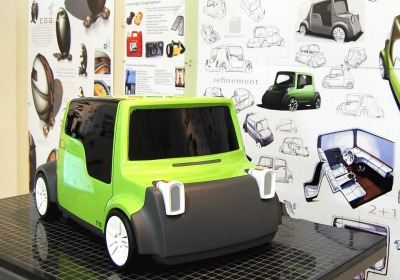College for Creative Studies Student Exhibition 2007
Mon, 23 Jul 2007The College for Creative Studies (CCS) in Detroit, Michigan hosted their Annual Student Exhibition in May this year, showing the work of more than 3,500 students. The Transportation Design program - sponsored by Toyota, Nissan and Honda - showed off the work of junior and senior students, each working from individual project briefs set by the automakers.
Toyota Motor Sales and the company's Calty Design Center challenged students to create a "bridge" vehicle to pull current Scion customers into the Toyota brand as they mature and experience lifestyle transitions. In all, twenty juniors participated in the TMS- and Calty- sponsored project, which called for students to develop a vehicle concept and strategy for the year 2012 while infusing Toyota's key design principles dubbed 'Vibrant Clarity' and 'J-Factor'.
"The need for a vehicle that moves us effortlessly into new life chapters was the challenge behind the Bridge Project," says Kevin Hunter, Calty vice president of design and studio operations. "Scion customers need the right Toyota vehicle as they grow into different life phases like marriage, family and employment."
While the Bridge Project was open to all vehicle segments, students were challenged to create a concept that took vehicle purpose, market influences and buyer demographics into consideration.
"The project challenged our students to develop the right cars for transitional life phases," said Bryon Fitzpatrick, Chair of Transportation Design at CCS. "For more than a decade, we have partnered with Toyota on educational initiatives through sponsored projects and student internships which reflect their ongoing commitment to and support for design education."
Nissan took a different approach, calling for a vehicle conceived for emerging markets vehicle for the year 2015. Designing a basic vehicle that would be suitable for two people and a small amount of luggage, the student concepts had to conform to safety regulations, satisfy green standards, have an appropriate level of comfort and amenities and above all be affordable. Throughout the project, students focused on the design of the vehicle's exterior and interior and took an in-depth look at the many complex elements that are inherent to the product.
The concepts were reviewed by Nissan Design executives including CCS alumnus Bruce Campbell, director of design at Nissan Design North America. Nissan recognized several students with awards based on their concepts: Dillon Blanski was recognized for the Best Design, Rob Cameron and Ji-Hoon Kim received honorable mentions for their concepts and Steve Green and John Kim were also given special awards.
Honda's brief requested that students create a futuristic Halo S-2000 sports car, based on the company's racing heritage, identity and philosophy. In order to accurately create concepts that would target the proposed market segment, students researched economically viable manufacturing techniques for a vehicle of this type.
While following Honda's conceptual design philosophy, students conducted market research, bench-marketing and package development. The result was several cars that aim to appeal to the special-interest, niche-market sector, with typically high expectations of quality. While following Honda's conceptual design philosophy, students conducted market research, bench-marketing and package development.
Related Stories:
College for Creative Studies Student Exhibition 2006
By



